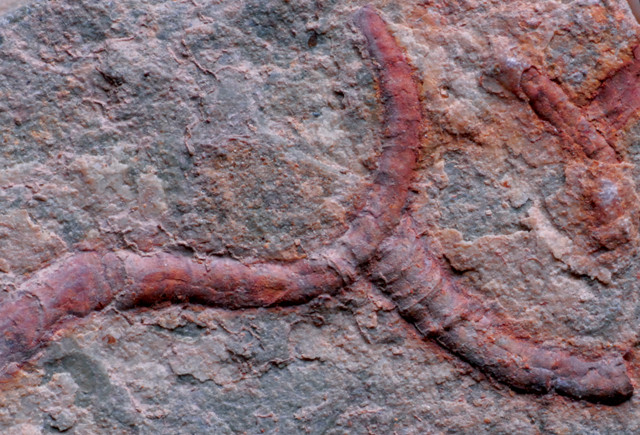
by Mary Caperton Morton Monday, March 9, 2015

Pyritized specimens of the wormlike Conotubus from the Gaojiashan Lagerstätte in China. Credit: Yaoping Cai, Northwest University, Xi'an China.
Most of the fossil record is composed of hard bones and shells — only a handful of places preserve fossils of soft-bodied organisms from early in Earth’s evolutionary history. The processes by which these delicate fossils form are not well understood, but a new study looking at an assemblage of 550-million-year-old soft-bodied fossils found in China sheds light on one potential mechanism.
The siltstone Gaojiashan Lagerstätte in southern China preserves a trove of soft-bodied fossils dating to the Ediacaran Period. “One thing that makes this site so interesting is that we see two different types of [soft-bodied] preservation here,” says James Schiffbauer, a paleontologist at the University of Missouri at Columbia and lead author of the new study, published in Nature Communications.
Roughly 80 percent of the worm-like fossils known as Conotubus recovered from Gaojiashan are preserved as 3-D tubes made of pyrite, an iron sulfide mineral better known as fool’s gold. The remaining 20 percent are found as two-dimensional carbonaceous compressions — formed when the weight of overlying sediment squashes a specimen flat and leaves a carbon residue — similar to those at other Precambrian fossil sites like the Burgess Shale in British Columbia. “This is the same animal preserved in two different ways. So that question begs: What’s different about these two preservational pathways?” Schiffbauer says.
To study the pyrite pathway, Schiffbauer and his colleagues ran geochemical tests on the fossils and found that the outside of the tubes had different sulfur isotopic signatures than the inside. “This means that the outside of the tube was [converted into pyrite] first, and then the pyrite grew inward,” he says. The finding suggested “a mechanism for, and put a timeline on, the sequence of events that led to the fossilization of these animals.”
The pyritization process was likely fueled by the same sulfate-reducing bacteria that consumed the worm’s soft tissue before the outer tube of the worm was fossilized. “In this case, the destructive process and the constructive process are exactly the same,” Schiffbauer says.
So what determined how the fossils were preserved in the Gaojiashan? Probably how long the animal carcass spent in the zone of sediment where these sulfur-reducing bacteria live, Schiffbauer says. If it lingered there long, it was gobbled up and pyritized; but if it were buried quickly by sediment and pushed below the sulfate-reduction zone, it would form a carbonaceous imprint. When pyritization did occur, it likely happened quickly in comparison to other pathways of fossilization, in as little as 12 years or as long as 800 years depending on calculations from a range of potential pyritization rates.
The study illuminates the preservational processes at this one site, but it’s unlikely to apply to other sites where soft-bodied tissues have been preserved as fossils, says Robert Gaines, a geochemist at Pomona College in Claremont, Calif., who was not involved in the new research. “In the Burgess Shale deposits, we only see rapid burial events,” so this issue of burial time in the sulfate-reduction zone doesn’t apply to the Burgess fossils, he says.
However, Schiffbauer’s study may prove useful in helping replicate pyrite preservational processes in the lab to study how the fossilization process works. “People have been working on replicating this process for some time with very limited success,” Gaines says. “This study makes some specific predictions that would be excellent for designing laboratory experiments around. It will be interesting to see if anybody takes this work and runs with it in that direction.”
© 2008-2021. All rights reserved. Any copying, redistribution or retransmission of any of the contents of this service without the expressed written permission of the American Geosciences Institute is expressly prohibited. Click here for all copyright requests.